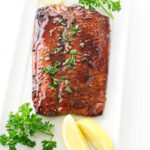Bourbon-Glazed Salmon Fillet
This honey bourbon glazed salmon gets marinated in a delicious sauce that does double duty as a glaze. This is a quick and easy dinner for any night of the week.
Servings: 2 servings
Ingredients
- ¼ cup packed brown sugar
- ¼ cup water
- 3 tablespoons bourbon
- 4 tablespoons soy sauce
- 1 tablespoon honey
- ¼ cup lime juice one lime
- 1 tablespoon fresh ginger peeled and grated
- ¼ teaspoon sea salt
- ¼ teaspoon freshly ground black pepper
- 3 garlic cloves minced
- 1 (12- oz) salmon fillet about 1-inch thick
- 2 tablespoons chopped fresh parsley for garnish
Instructions
- Combine the sugar, water, bourbon, soy sauce, honey, lime juice, ginger, salt, pepper and garlic in a shallow dish large enough to hold the salmon. Add the salmon fillet, turning in the marinade to coat completely, cover the dish with plastic wrap and place in the refrigerator for 30 minutes. Alternatively, you could place the salmon and marinade in a resealable bag.
- Preheat the oven to 425°F and coat a baking sheet or broiler pan with non-stick spray.
- Remove the salmon from the marinade and place skin side down on the baking sheet. Pour the marinade into a small saucepan. Bring the marinade to a boil over medium-high heat and cook for 4 to 5 minutes to reduce the liquid until it is slightly thick and syrupy.
- Brush some of the syrupy glaze over the top of the salmon. Transfer the baking sheet with the salmon to the oven and banke 8-11 minutes, or until fish flakes easily when tested with a fork.. When tested with a meat thermometer the center of the fillet should register 135°F. Do not over cook (see notes).
- To serve, transfer the salmon fillet to a serving platter and spoon some of the reduced marinade sauce over the top and garnish with the chopped fresh parsley.
Notes
- Don’t marinate the salmon too long. You only need 30 to 45 minutes for this bourbon marinated salmon. If you leave the fish in the marinade too long then the acids in the marinade will “cook” the salmon and the texture will be “off”.
- Make sure you boil the marinade. You don’t want to reuse a marinade as a sauce unless you kill all the potential pathogens. Not only will boiling the marinade make it safe to use, it will reduce the liquid and turn it into a thick, sticky glaze.
- The cooking time will depend on the thickness of your salmon fillet. Salmon typically takes 4 to 5 minutes for every 1/2 inch of thickness (when the oven is set at 425°F).
- For a more accurate temperature, use a meat thermometer and use the temperature guide in the post to find your desired doneness level for salmon.
Nutrition
Serving: 1 | Calories: 408kcal | Carbohydrates: 32g | Protein: 35g | Fat: 21g | Saturated Fat: 4g | Polyunsaturated Fat: 15g | Cholesterol: 107mg | Sodium: 2132mg | Fiber: 1g | Sugar: 32g
